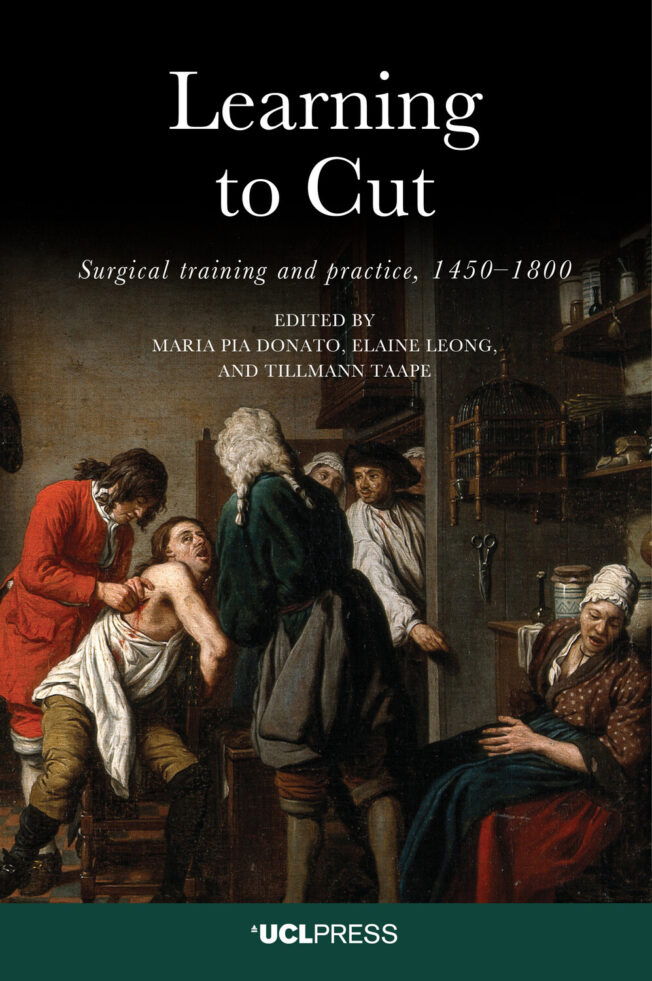
Learning to Cut
Surgical training and practice, 1450–1800
Maria Pia Donato (Editor), Elaine Leong (Editor), Tillmann Taape (Editor)
Across early modern Europe, surgeons played a key role in the provision of everyday healthcare. They dressed wounds, lanced boils, set bones, treated tumours, as well as performing specialist operations such as couching cataracts or cutting for the stone. They carried out anatomies and autopsies, prepared corpses for embalming, and, if they were entitled to do so, occasionally performed major operations such as removing cancers, amputating limbs, and trepanning skulls. Yet, while recent studies have done much to elucidate the work of surgeons, little has been published about how they were trained.
Learning to Cut fills this significant gap. A range of case studies from the French, Italian, German, and English contexts reveal diverse modes of surgical teaching and learning in across early modern towns and cities, and how they were shaped by existing social, economic, and occupational structures. Equally varied were the spaces and institutions where prospective practitioners learned and experienced surgery. Thus, the shop, the patient’s house, the hospital, the guild hall, and the university theatre were all sites for learning, teaching – and cutting. The chapters present rich narratives of education and, together, shed new light on the practice of early modern surgery.
List of figures
List of contributors
Acknowledgements
1 Introduction: Learning to cut and cutting to learn
Maria Pia Donato, Elaine Leong, and Tillmann Taape
Part I: Diversity of knowledge and practice
2 Learning to cut for the stone: training specialised surgeons in the Holy Roman Empire
Annemarie Kinzelbach
3 Learning to dress wounds: seventeenth-century Italian surgeons and their pharmaceutical competence
Sandra Cavallo
4 Surgical training and practice in sixteenth- and seventeenth-century Germany
Michael Stolberg
5 Leonardo Fioravanti, a (more) learned surgeon: surgical techne and the critique of anatomy
Cynthia Klestinec
Part II: Genealogies of surgical education
6 Learning surgery from medieval manuscripts
Peter Jones
7 ‘The ordinary terms of chest wounds’ or how to become a forensic surgical expert in early modern France. Evidence from a seventeenth-century surgical corporation notebook
Cathy McClive
8 ‘Trained up & now made apt to practise’: vernacular print and surgical training in early modern London
Elaine Leong
9 ‘His body, his honour, his health, and his handwork’: surgical training in printed books and in the city of artisans
Tillmann Taape
Part III: Epistemic modes and strategies of training
10 Learning from disaster: surgical mishaps and pedagogy in the age of print
Heidi Hausse
11 Teaching with images: Guglielmo Riva’s surgical pedagogy in seventeenth-century Rome
Silvia De Renzi
12 Entangled sites of pedagogy: André Levret’s Parisian midwifery course
Scottie Hale Buehler
13 ‘Proficient in all things surgical’. Apprentices learning and doing in Italian hospitals, 1670–1770
Maria Pia Donato
Index
DOI: 10.14324/111.9781806550999
Number of illustrations: 28
Publication date: 01 June 2026
EPUB ISBN: 9781806551002
Maria Pia Donato (Editor) 
Maria Pia Donato is CNRS Research Professor of History at the Institut d’Histoire Moderne et Contemporaine in Paris, France. She teaches the history of medicine and science at École Normale Supérieure in Paris. She is a specialist in early modern cultural history and she has written extensively on medicine and surgery, particularly in Italy, and on medicine, science and religion, especially in Catholic contexts. Her publications include Sudden Death. Medicine and Religion in Eighteenth-Century Rome (2014) and Medicine and the Inquisition in the Early Modern World (ed. 2019).
Elaine Leong (Editor) 
Elaine Leong is Associate Professor of History at University College London. Her research is centred upon medical and scientific knowledge transfer and production with a particular focus on gender and the everyday. She is the author of Recipes and Everyday Knowledge: Medicine, Science and the Household in Early Modern England (Chicago 2018) and the editor of a number of essay volumes and journal special issues, including Working with Paper: Gendered Practices in the History of Knowledge (Pittsburgh, 2019); “Learning by the Book: Manuals and Handbooks in the History Science” (BJHS Themes, 2020) and “Translating Medicine Across Premodern Worlds” (Osiris, 2022).
Tillmann Taape (Editor) 
Tillmann Taape is a research fellow and lecturer in history of medicine at the Charité Medical School, Berlin, Germany. His work explores the relationships between artisanal, alchemical, and medical forms of knowledge in the early modern period. His monograph Crafting Medicine, explores how the artisan-author Hieronymus Brunschwig and his works on surgery and distillation shaped early modern understandings of medical practice and the body. Tillmann has co-edited a special issue on premodern Fire Arts for Ambix.
Related titles
Learning to Cut
Surgical training and practice, 1450–1800
Across early modern Europe, surgeons played a key role in the provision of everyday healthcare. They dressed wounds, lanced boils, set bones, treated tumours, as well as performing specialist operations such as couching cataracts or cutting for the stone. They carried out anatomies and autopsies, prepared corpses for embalming, and, if they were entitled to do so, occasionally performed major operations such as removing cancers, amputating limbs, and trepanning skulls. Yet, while recent studies have done much to elucidate the work of surgeons, little has been published about how they were trained.
Learning to Cut fills this significant gap. A range of case studies from the French, Italian, German, and English contexts reveal diverse modes of surgical teaching and learning in across early modern towns and cities, and how they were shaped by existing social, economic, and occupational structures. Equally varied were the spaces and institutions where prospective practitioners learned and experienced surgery. Thus, the shop, the patient’s house, the hospital, the guild hall, and the university theatre were all sites for learning, teaching – and cutting. The chapters present rich narratives of education and, together, shed new light on the practice of early modern surgery.
